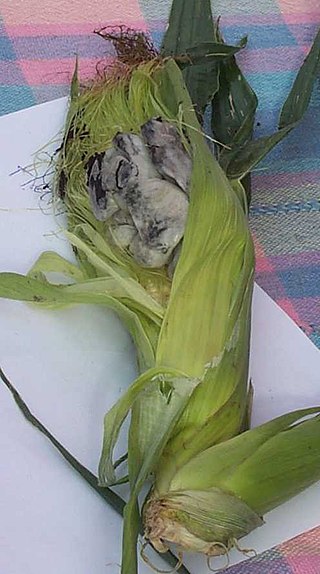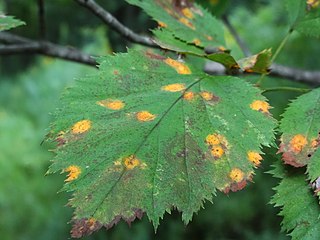
Teliospore (sometimes called teleutospore) is the thick-walled resting spore of some fungi (rusts and smuts), from which the basidium arises.

Teliospore (sometimes called teleutospore) is the thick-walled resting spore of some fungi (rusts and smuts), from which the basidium arises.
They develop in telia (sing. telium or teliosorus).
The telial host is the primary host in heteroecious rusts. The aecial host is the alternate host (look for pycnia and aecia).
These terms apply when two hosts are required by a heteroecious rust fungus to complete its life cycle.
Teliospores consist of one, two or more dikaryote cells.
Teliospores are often dark-coloured and thick-walled, especially in species where they overwinter (acting as chlamydospores).
Two-celled teliospores formerly defined the genus Puccinia . Here the wall is particularly thick at the tip of the terminal cell which extends into a beak in some species.
Teliospores consist of dikaryote cells. As the teliospore cells germinate, the nuclei undergo karyogamy and thereafter meiosis, giving rise to a four-celled basidium with haploid basidiospores.

Basidiomycota is one of two large divisions that, together with the Ascomycota, constitute the subkingdom Dikarya within the kingdom Fungi. Members are known as basidiomycetes. More specifically, Basidiomycota includes these groups: agarics, puffballs, stinkhorns, bracket fungi, other polypores, jelly fungi, boletes, chanterelles, earth stars, smuts, bunts, rusts, mirror yeasts, and Cryptococcus, the human pathogenic yeast.

In biology, a spore is a unit of sexual or asexual reproduction that may be adapted for dispersal and for survival, often for extended periods of time, in unfavourable conditions. Spores form part of the life cycles of many plants, algae, fungi and protozoa.

Rusts are fungal plant pathogens of the order Pucciniales causing plant fungal diseases.

A basidium is a microscopic spore-producing structure found on the hymenophore of reproductive bodies of basidiomycete fungi. These bodies also called tertiary mycelia, which are highly coiled versions of secondary mycelia. The presence of basidia is one of the main characteristic features of the genus. A basidium usually bears four sexual spores called basidiospores. Occasionally the number may be two or even eight. Each reproductive spore is produced at the tip of a narrow prong or horn called a sterigma (pl. sterigmata), and is forcefully expelled at full growth.

Zygomycota, or zygote fungi, is a former division or phylum of the kingdom Fungi. The members are now part of two phyla: the Mucoromycota and Zoopagomycota. Approximately 1060 species are known. They are mostly terrestrial in habitat, living in soil or on decaying plant or animal material. Some are parasites of plants, insects, and small animals, while others form symbiotic relationships with plants. Zygomycete hyphae may be coenocytic, forming septa only where gametes are formed or to wall off dead hyphae. Zygomycota is no longer recognised as it was not believed to be truly monophyletic.

A basidiospore is a reproductive spore produced by Basidiomycete fungi, a grouping that includes mushrooms, shelf fungi, rusts, and smuts. Basidiospores typically each contain one haploid nucleus that is the product of meiosis, and they are produced by specialized fungal cells called basidia. Typically, four basidiospores develop on appendages from each basidium, of which two are of one strain and the other two of its opposite strain. In gills under a cap of one common species, there exist millions of basidia. Some gilled mushrooms in the order Agaricales have the ability to release billions of spores. The puffball fungus Calvatia gigantea has been calculated to produce about five trillion basidiospores. Most basidiospores are forcibly discharged, and are thus considered ballistospores. These spores serve as the main air dispersal units for the fungi. The spores are released during periods of high humidity and generally have a night-time or pre-dawn peak concentration in the atmosphere.

A chlamydospore is the thick-walled large resting spore of several kinds of fungi, including Ascomycota such as Candida, Basidiomycota such as Panus, and various Mortierellales species. It is the life-stage which survives in unfavourable conditions, such as dry or hot seasons. Fusarium oxysporum which causes the plant disease Fusarium wilt is one which forms chlamydospores in response to stresses like nutrient depletion. Mycelia of the pathogen can survive in this manner and germinate in favorable conditions.

Urediniospores are thin-walled spores produced by the uredium, a stage in the life-cycle of rusts.

The Ustilaginales are an order of fungi within the class Ustilaginomycetes. The order contained 8 families, 49 genera, and 851 species in 2008.

The Ustilaginomycotina is a subdivision within the division Basidiomycota of the kingdom Fungi. It consists of the classes Ustilaginomycetes and Exobasidiomycetes, and in 2014 the subdivision was reclassified and the two additional classes Malasseziomycetes and Monilielliomycetes added. The name was first published by Doweld in 2001; Bauer and colleagues later published it in 2006 as an isonym. Ustilagomycotina and Agaricomycotina are considered to be sister groups, and they are in turn sister groups to the subdivision Pucciniomycotina.
This is a glossary of some of the terms used in phytopathology.
Sporogenesis is the production of spores in biology. The term is also used to refer to the process of reproduction via spores. Reproductive spores were found to be formed in eukaryotic organisms, such as plants, algae and fungi, during their normal reproductive life cycle. Dormant spores are formed, for example by certain fungi and algae, primarily in response to unfavorable growing conditions. Most eukaryotic spores are haploid and form through cell division, though some types are diploid sor dikaryons and form through cell fusion.we can also say this type of reproduction as single pollination

Gymnosporangium globosum is a fungal plant pathogen that causes cedar-hawthorn rust.

Gymnosporangium sabinae is a species of rust fungus in the subdivision Pucciniomycotina. Known as pear rust, European pear rust, or pear trellis rust, it is a heteroecious plant pathogen with Juniperus sabina as the main primary (telial) host and Pyrus communis as the main secondary (aecial) host.

Puccinia jaceae var. solstitialis is a species of fungus in the Pucciniaceae family. It is a plant pathogen that causes rust. Native to Eurasia, it is the first fungal pathogen approved in the United States as a biological control agent to curb the growth of the invasive weed yellow starthistle.

Telium, plural telia, are structures produced by rust fungi as part of the reproductive cycle. They are typically yellow or orange drying to brown or black and are exclusively a mechanism for the release of teliospores which are released by wind or water to infect the alternate host in the rust life-cycle. The telial stage provides an overwintering strategy in the life cycle of a parasitic heteroecious fungus by producing teliospores; this occurs on cedar trees. A primary aecial stage is spent parasitizing a separate host plant which is a precursor in the life cycle of heteroecious fungi. Teliospores are released from the telia in the spring. The spores can spread many kilometers through the air, however most are spread near the host plant.

Phragmidium is a genus of rust fungus that typically infects plant species in the family Rosaceae. It is characterised by having stalked teliospores borne on telia each having a row of four or more cells. All species have a caeoma which is a diffuse aecidium lacking a peridium.

Puccinia mariae-wilsoniae, commonly known as the spring beauty rust, is a species of rust fungus found in North America. A plant pathogen, it grows on the leaves of the spring beauty flowering plants Claytonia caroliniana and C. virginica.
Puccinia libanotidis, common name moon carrot rust, is a species of rust that infects the moon carrot, Seseli libanotis. It is restricted to the same range as its host plant across Eurasia.

Puccinia sorghi, or common rust of maize, is a species of rust fungus that infects corn and species from the plant genus Oxalis.